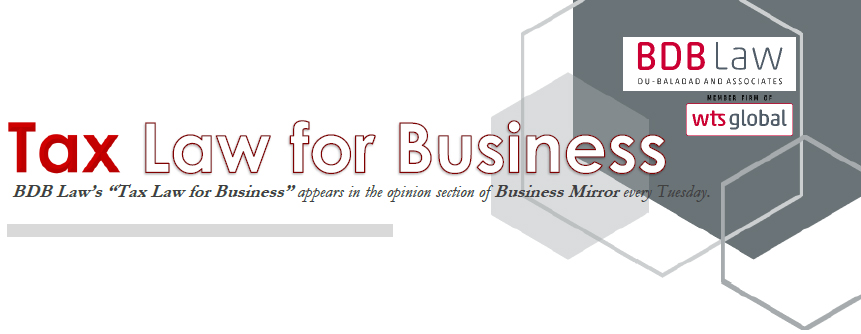
EASE OF PAYING TAXES – ON CHANGES IN THE REGULATIONS
By: Atty. Jomel N. Manaig
"Now, the long wait is finally over. The RRs are finally here, a total of 6. So, what provisions of the initial draft underwent significant changes? "
 Atty. Jomel N. Manaig +632 8403-2001 loc. 140 |
After some agonizing weeks of speculation and anticipation, the final versions are in! Ladies and gentlemen, please welcome, the EOPT RRs!
Just a quick trip to recent history, in February 2024 the draft revenue regulations (RR) for the EOPT were released and public consultations were held. The draft RRs were received with mixed reactions and some questions were left unanswered. Even I and my Partners from the Firm wrote extensively on the EOPT and its draft RR: from changes in the filing of tax returns to the revisions in VAT provisions, and even to the overhauls in the refund process.
 Now, the long wait is finally over. The RRs are finally here, a total of 6. So, what provisions of the initial draft underwent significant changes?
Now, the long wait is finally over. The RRs are finally here, a total of 6. So, what provisions of the initial draft underwent significant changes?
A very noticeable change is in the filing of returns and payment of the corresponding taxes. In the initial draft, the primary mode for both filing and payment is electronically and only upon the unavailability of electronic means will the taxpayer be allowed to file and pay manually. However, in the RR, the electronic means as a primary mode now applies only to the filing of tax returns. Payment of taxes may either be electronically or manually done, at the option of the taxpayer.
It should be noted that under the EOPT Act itself, the filing of tax returns and the payment of the corresponding taxes may be done either electronically or manually. There is no qualification nor preference referred to in the text of the law. The preference for electronic means only appeared in the RR. Nonetheless, from the point of view of better tax administration, it is preferable to have tax returns be in electronic format rather than the archaic paper system. Dare I say, this preference may even be an improvement to the underlying goals of the EOPT itself.
On the subject of refund, a major aspect changed from the initial draft and public consultation to the actual RR. Under the EOPT, upon the lapse of the period to process a claim for tax credit/refund, the taxpayer would have the option to appeal directly to the CTA within 30 days. The public consultation on the draft RR added some depth to this remedy by revealing that the taxpayer may opt to wait for the BIR to process the claim beyond the prescribed period. Once a decision is rendered, despite the lapse of the period to process the claim, the taxpayer would still be eligible to appeal the unfavorable decision to the CTA.
This, of course, was met with cautious skepticism since the EOPT did not expressly provide such a remedy. And such skepticism appeared to have a dash of accuracy to it. The actual RR now expressly recognizes that waiting for the decision on the claim for refund beyond the prescribed period to process would mean foregoing the remedy of appeal with the CTA. It is fortunate that the RR provisions on the remedy were changed to what they are now. Otherwise, we could expect some confusion as the refund provisions of the EOPT Act are put into action. Such confusion may impair the remedies available to taxpayers.
Another change in the rules for claims for refund is on the processing of refund claims in relation to the dissolution or cessation of business. In the initial draft, the 2-year prescriptive period refers to the filing of the application for cash refund which is reckoned from the issuance of the BIR Tax Clearance. Afterwards, the BIR has 180 days within which to act on the application.
However, the actual RR modified this by using the 2-year prescriptive period as the basis for the period of processing the claim for refund. It even expressly mentioned that this is an exception to the general 180-day period. This 2-year period would commence from the filing of the application for registration cancellation (BIR Form 1905) together with the complete documentary requirements for both the closure and the refund. Based on the actual RR, the claim for refund in relation to dissolutions or cessation of business is supposed to be filed together with the application for registration update.
Claims for refund were just among those that were clarified in the recently issued RRs. The EOPT also brought in significant changes to the way VAT is imposed and questions came along with it. Some questions dealt with the transition from the old rules to the new one. How will it be done and what will happen to transactions entered into during the pendency of the effectivity of the implementing rules and regulations?
In the draft RR, for sale of services with receivables that are still outstanding prior to the effectivity of the regulations, taxpayers were being required to report the sale and the corresponding output VAT in the immediate taxable quarter. This posed an unfavorable requirement for taxpayers since they will be required to apply the revisions of the EOPT Act to transactions that were entered into before it came into effect.
Giving credit where credit is due, the DOF and the BIR wisely changed its position in the actual RR and require the affected taxpayers to declare the output VAT on these transactions once the receivables are collected. This is a more reasonable transitory policy.
The EOPT RRs seem to still be a hit or miss in some areas. However, I would have to commend the improvements made from the initial drafts. Here is to hoping that the succeeding clarifications or amendments would further make taxpayers’ lives more at ease.
The author is a junior partner of Du-Baladad and Associates Law Offices (BDB Law), a member-firm of WTS Global.
The article is for general information only and is not intended, nor should be construed as a substitute for tax, legal or financial advice on any specific matter. Applicability of this article to any actual or particular tax or legal issue should be supported therefore by a professional study or advice. If you have any comments or questions concerning the article, you may e-mail the author at This email address is being protected from spambots. You need JavaScript enabled to view it. or call 8403-2001 local 140.




